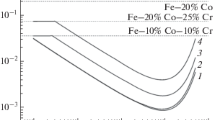Abstract
A thermodynamic analysis of the oxygen solutions in carbon-containing Fe, Fe–70% Ni, and Ni melts is performed. The equilibrium constants of the reaction of carbon with oxygen, the activity coefficients at infinite dilution, and the interaction parameters for the melts are determined at 1873 K. The dependences of the oxygen solubility in the melts on the carbon content are calculated. The oxygen concentrations in the Fe and Ni melts with the same carbon content differ by almost two orders of magnitude. The CO and CO2 gaseous oxides are the products of carbon deoxidation. A decrease in the gas pressure substantially increases the deoxidation ability of carbon. The oxygen solubility in the Fe–70% Ni melt with different carbon contents is studied experimentally. The experimental results adequately agree with the calculated data.





Similar content being viewed by others
REFERENCES
Yi Liu, D. J. Sellmyer, and D. Shindo, Handbook of Advanced Magnetic Materials: 4 v. V. I: Advanced Magnetic Materials: Nanostructural Effects (Springer, Boston, 2006).
M. Hino and K. Ito, Thermodynamic Data for Steelmaking (Tohoku University Press, Sendai, 2010).
G. K. Sigworth, J. F. Elliott, G. Vaughn, and G. H. Geiger, “The thermodynamics of dilute liquid nickel alloys,” Metall. Soc. CIM, Annual Vol., 104–110 (1977).
I. S. Kulikov, Deoxidation of Metals (Metallurgiya, Moscow, 1975).
A. M. Katsnelson, V. Ya. Dashevskii, and V. I. Kashin, “Calculation of \(\varepsilon _{{\text{C}}}^{i}\) parameters in iron-, cobalt-, nickel-, and manganese-based melts using data on the effect of alloying elements on the carbon solubility”, Izv. Vyssh. Uchebn. Zaved., Chern. Metall., No. 12, 7–15 (1992).
E. T. Turkdogan, Fundamentals of Steelmaking (Maney Publishing, Leeds, 2010).
V. Ya. Dashevskii, A. A. Aleksandrov, A. G. Kanevskii, and M. A. Makarov, “Deoxidation equilibrium of vanadium in the iron-nickel melts”, ISIJ Intern. 49 (2), 149–155 (2009).
M. G. Frohberg and M. Wang, “Thermodynamic properties of sulphur in liquid copper–antimony alloys at 1473 K,” Z. Metallkd. 81 (7), 513–515 (1990).
K. Lyupis, Chemical Thermodynamics of Materials (Metallurgiya, Moscow, 1989).
A. A. Aleksandrov, M. A. Makarov, and V. Ya. Dashevskii, “Solubility of oxygen in carbon-bearing Fe–Ni melts,” Russ. Metall. (Metally), No. 4, 279–285 (2006).
T. Chiang and Y. A. Chang, “The activity coefficient of oxygen in binary liquid metal alloys,” Met. Trans. B 7, 453–457 (1976).
A. M. Samarin and R. A. Karasev, “On the carbon and oxygen activities in iron–carbon–oxygen melts,” Izv. Akad. Nauk SSSR, OTN, No. 8, 1130–1136 (1953).
R. Hultgren, P. D. Desai, D. T. Hawkins, M. Gleiser, and K. K. Kelley, Selected Values of the Thermodynamic Properties of Binary Alloys (Metals Park ASM, Ohio, 1973).
A. A. Aleksandrov and V. Ya. Dashevskii, “Thermodynamics of the oxygen solutions in chromium-containing Ni–Co melts,” Russ. Metall. (Metally), No. 7, 642–648 (2016).
A. Yu. Polyakov, A. M. Samarin, and Sui Tsen-Tszi, “Thermodynamic characteristics of reaction of carbon and oxygen in liquid iron,” Izv. Akad. Nauk SSSR, OTN, Metall. Toplivo, No. 1, 3–9 (1961).
S. Marshall and J. Chipman, “The carbon–oxygen equilibrium in liquid iron,” Trans. ASM. 30, 695–746 (1942).
S. Matoba and S. Banya, “Equilibrium of carbon and oxygen in molten iron saturated with carbon,” Tetsu-to-Hagane 43 (8), 790–796 (1957).
T. Fuwa and J. Chipman, “The carbon–oxygen equilibria in liquid iron,” Trans. Met. Soc. AIME 218, 887–891 (1960).
V. P. Luzgin, A. F. Vishkarev, and V. I. Yavoiskii, “On the interaction of oxygen with carbon in liquid iron,” Izv. Vyssh. Uchebn. Zaved., Chern. Metall., No. 1, 22–25 (1965).
N. Matsumoto, “The equilibrium between carbon and oxygen dissolved in liquid iron and carbon monoxide under high pressure,” J. Japan Inst. Metals 31 (4), 460–465 (1967).
V. T. Burtsev and V. I. Kashin, “Interaction of carbon with oxygen in iron, cobalt, and nickel melts at different partial pressures of carbon oxide,” Stal’, No. 7, 603–608 (1974).
Syui Tszya-Lun, V. I. Kashin, A. Yu. Polyakov, and A. M. Samarin, “Study of deoxidizing capacity of carbon in liquid nickel,” Izv. Akad. Nauk SSSR, Metall. Gorn. Delo, No. 6, 75–80 (1964).
B. V. Linchevskii and V. Ya. Dashevskii, ““Chemical vacuum”—a concept to be refined,” Russ. Metall. (Metally), No. 9, 763–767 (2010).
Funding
This study was performed in terms of state assignment no. 075-00715-22-00.
Author information
Authors and Affiliations
Corresponding author
Ethics declarations
The authors declare that they have no conflicts of interest.
Additional information
Translated by N. Kolchugina
Rights and permissions
About this article
Cite this article
Aleksandrov, A.A., Kanevskii, A.G. Effect of Carbon on the Oxygen Solubility in an Fe–70% Ni Melt. Russ. Metall. 2022, 488–495 (2022). https://doi.org/10.1134/S0036029522050020
Received:
Revised:
Accepted:
Published:
Issue Date:
DOI: https://doi.org/10.1134/S0036029522050020




